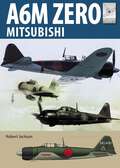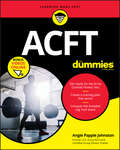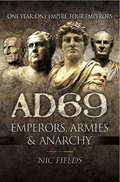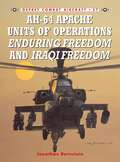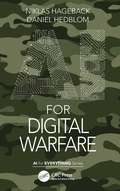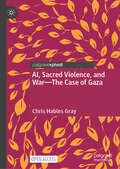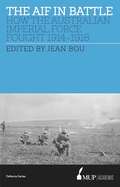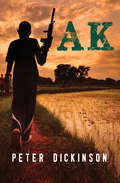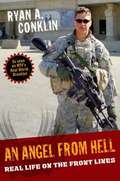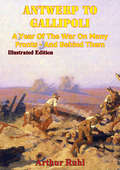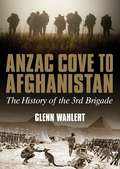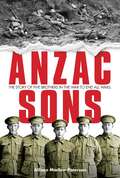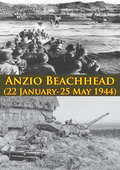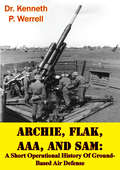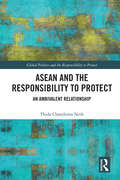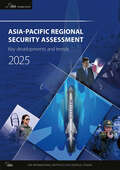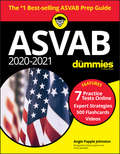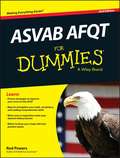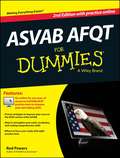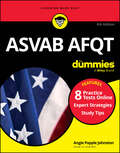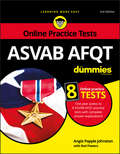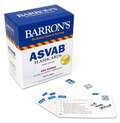- Table View
- List View
A6M Zero Mitsubishi (FlightCraft #22)
by Robert JacksonThis detailed study of Japan’s fearsome WWII fighter covers its legendary combat career along with color images and technical information.The quality of Japan’s Mitsubishi A6M Zero shocked Allies Forces at the outbreak of the Pacific War. Armed with two 20mm cannon and two 7.7mm machine-guns, it was highly maneuverable and structurally very strong, despite being lightweight. When it first took flight in 1939, it was far superior to any other fighter in the skies.During the first months of the Pacific War, the Zeros carved out an impressive combat record. For example, in the battle for Java alone, they destroyed 550 Allied aircraft. But it eventually outclassed by American fighters such as the Grumman F6F Wildcat and Vought Corsair. In the latter months, many were fitted with bombs and expended in Kamikaze suicide attacks.This book provides a detailed overview of the design and combat career of a fighter that made history. Ideal for modelers and military history enthusiasts, it offers a wealth of technical information, photographs and color profiles.
ACFT For Dummies
by Angela Papple JohnstonThe best standalone resource for the Army Combat Fitness Test As the Army prepares to shift to the new Army Combat Fitness Test (ACFT) from the Army Physical Fitness Test, hundreds of thousands of new and current servicemembers will have to pass a more rigorous and demanding set of physical events to prove they have what it takes to meet the physical demands of an army job. Utilizing the accessible and simple approach that has made the For Dummies series famous the world over, ACFT For Dummies is packed with everything you need to train for and ultimately crush the ACFT. Topics include: An overview of the test, including how it fits into your army role How the test is administered (location, equipment, etc.) Instructions on how to perform each of the six events How the ACFT is scored Training for the ACFT on your own time The importance of recovery, including essential stretches How to build your own workout routine Videos for each of the six events with tips for how to train for them The ACFT For Dummies prepares readers to tackle the new, tougher Army fitness test with practical examples and concrete strategies that will push each servicemember to new heights.
AD69: Emperors, Armies and Anarchy
by Nic FieldsThe author of God&’s Viking brings to life &“a period in Roman history that provides many twists and turns as Rome emerged from the period of rule by Nero&” (Firetrench). With the death of Nero by his own shaky hand, the ill-sorted, ill-starred Julio-Claudian dynasty came to an ignominious end, and Rome was up for the taking. This was 9 June, AD 68. The following year, commonly known as the &“Year of the Four Emperors,&” was probably one of Rome&’s worst. In all previous successions, the new emperor had some relation to his predecessor, but the psychotic and paranoid Nero had done away with any eligible relatives. The new emperor had to secure his legal position and authority with regards to the Senate and to the army, as well as to those who had a vested interest in the system, the Praetorian Guard. Because imperial authority was ultimately based on control of the military, a player in the game of thrones had to gain an unshakable command over the legions. Of course, this in turn meant that the soldiers themselves could impose their own choice. It was to take a tumultuous year of civil war and the death of three imperial candidates before a fourth candidate could come out on top, remain there, and establish for himself a new dynasty. Nic Fields narrates the twists and turns and the military events of this short but bloody period of Roman history. &“We appear to meet more people than the cast of Game of Thrones (with about the same mortality rate!) but with the added bonus of this being history, not fiction . . . hugely entertaining.&”—Miniature Wargames Magazine
AH-64 Apache Units of Operations Enduring Freedom & Iraqi Freedom
by Jim Laurier Jonathan BernsteinAfter the attacks on 11 September 2001, Apache units made significant contributions to the Coalition campaign against Taliban and al-Qaeda forces in Afghanistan. Functioning as the 'killer' part of US Army Hunter-killer teams, Apaches sought out and brought overwhelming firepower to bear on Taliban and al-Qaeda forces, as well as providing direct support to Coalition troops on the ground. Apaches spearheaded the advance of the 3rd Infantry and the 101st airborne divisions into Iraq, engaging in some of the heaviest fighting along the western axis of advance. Weather and enemy fire took a heavy toll on Apaches operating in Western Iraq, but the resilience and flexibility of the Apache was central to the success of this campaign.
AI for Digital Warfare (AI for Everything)
by Niklas Hageback Daniel HedblomAI for Digital Warfare explores how the weaponising of artificial intelligence can and will change how warfare is being conducted, and what impact it will have on the corporate world. With artificial intelligence tools becoming increasingly advanced, and in many cases more humanlike, their potential in psychological warfare is being recognised, which means digital warfare can move beyond just shutting down IT systems into more all-encompassing hybrid war strategies.
AI, Sacred Violence, and War—The Case of Gaza
by Chris Hables GrayThis open access book is about how Israel is using Algorithmic Intelligence (AI) and other computer technology in military operations in the Gaza Strip to achieve goals based on ancient religious entitlements. Changes in Israel Defense Force (IDF) ethical codes and innovation policies have not led to victory, but have resulted in a wide range of War Crimes and Crimes Against Humanity in a strategy focused on The Torture of Gaza, which includes ethnic cleansing and is approaching genocide. It covers the history of using AI in war, and current U.S. and Israeli military AI technologies such as Maven, Iron Dome, Pegasus, the Alchemist, Gospel, Lavender, and Where’s Daddy, all tested and perfected in the Palestinian Laboratory and marketed as such. This book also places the current data-driven and AI-directed assault on Palestine in the context of Postmodern War, which precludes military victories and enshrines the profits and power of the U.S.-Israeli military-industrial complex in a system of perpetual war and militarized technological innovation. Through an analysis of Israeli military policies, AI, sacred texts, and the basic tenets of postmodern war, the book ultimately reveals the limits of the IDF’s embrace of illusions about new technologies producing actual victory. War today is about winning hearts and minds, not body counts. As fundamentalist politics achieve more and more power around the world in the context of new information technologies, there is growing danger to the future of all of us.
AIF in Battle: How the Australian Imperial Force Fought, 1914–1918
by Jean BouBy the end of the First World War the combat formations of the Australian Imperial Force (AIF) in both France and the Middle East were considered among the British Empire's most effective troops. While sometimes a source of pride and not a little boasting, how the force came to be so was not due to any inherent national prowess or trait. Instead it was the culmination of years of training, organisational change, battlefield experimentation and hard-won experience—a process that included not just the Australians, but the wider British imperial armies as well.This book brings together some of Australia's foremost military historians to outline how the military neophytes that left Australia's shores in 1914 became the battle winning troops of 1918. It will trace the evolution of several of the key arms of the AIF, including the infantry, the light horse, the artillery, and the flying corps, and also consider how the various arms worked together alongside other troops of the British Empire to achieve a remarkably high level of battlefield effectiveness.
AK
by Peter DickinsonA war behind him, a child soldier tries to learn the ways of peace Paul remembers nothing from before the conflict. Twelve years old, he is not a child. He is a warrior--one of a handful of elite commandos who live only to fight the corrupt government of Nagala. He has no family but the boys who fight beside him, and he owns nothing but his AK-47 rifle. This is the only life he has ever known, and it is one he understands--right until the day the standoff ends and his life changes forever. Paul buries his AK and heads north to join a school and attempt to live life as just another child. But at night, the battlefield consumes his dreams. When a rogue faction stages a coup in the capital and Paul's adoptive father is put in prison, the boy turns into a warrior once more. It is too late for him to have a childhood, but Paul will do whatever it takes to guarantee himself a future. This ebook features an illustrated personal history of Peter Dickinson including rare images from the author's collection.
AN Angel From Hell
by Ryan A. ConklinWith new material- the gripping war memoir by a young veteran and cast member of The Real World: Brooklyn. With new material about Ryan Conklin's second tour in Iraq, An Angel from Hell is a gritty, blunt, sometimes laugh-out-loud Iraq war memoir from the grunt's perspective. This is an edgy, candid report from the front lines and a captivating coming-of-age story by a young veteran and former cast member of The Real World: Brooklyn. With stunning candor and wisdom beyond his years, Ryan Conklin gives voice to a complex and life-changing experience for his generation.
ANTWERP TO GALLIPOLI - A Year of the War on Many Fronts - and Behind Them [Illustrated Edition]
by Arthur Brown RuhlIncludes Gallipoli Campaign Map and Illustrations Pack -71 photos and 31 maps of the campaign spanning the entire period of hostilities.Written in the tumultuous days of the opening months of the First World War, American writer Arthur Ruhl was one of the few English speaking journalists who saw first-hand behind the German and Turkish lines. He initially reported from the Belgian front, and accompanied the German Army as it marched to seeming victory; but they were bloodily stopped at the battle of the Marne by the French and then again by the British at Ypres. Ruhl then travelled to the far side of Europe to report on the struggles between the Turkish army and the British, French and Anzac forces at Gallipoli. The book he penned is vivid, immediate and filled with graphic vignettes of the fighting that he witnessed.Warmly recommended.
ANZAC Cove to Afghanistan: The History of the 3rd Brigade
by Glenn WahlertAs the first Anzacs to land at Gallipoli on 25 April 1915 and among the last to serve in Afghanistan 100 years later, the men and women of the Australian Army&’s 3rd Brigade have a long and proud history. Initially raised in 1903, the 3rd Brigade served as part of the Australian Imperial Force during World War I, suffering appalling losses at Gallipoli. On the Western Front the brigade endured three years of horrendous trench warfare, its four infantry battalions alone incurring a casualty rate of over 300%. During the inter-war period the brigade was a militia force and was mobilised with Japan&’s entry into the war in 1941, serving in Darwin, Papua New Guinea and North Queensland. Disbanded in 1944 and re-formed as the 3rd Task Force in 1967, the soldiers of the 3rd Brigade have deployed to almost every theatre in which the Australian Defence Force has seen action, including Vietnam, the South Pacific, Somalia, Cambodia, Rwanda, Bougainville, Timor-Leste, Solomon Islands, Iraq and Afghanistan. From 1980 the brigade has been the government&’s land force instrument of first choice in response to military or peacekeeping interventions throughout the world and natural disasters at home. This is a heritage of which all Australians can be justifiably proud.
ANZAC Sons: The Story of Five Brothers in the War to End All Wars (Australia Remembers Ser.)
by Allison Paterson"Well dear Jim it breaks my heart to write this letter. Our dear [brother] was killed yesterday morning at 5.30. The bullet killed him instantly and he never spoke a word. I had just left him and gone down the trench to see the other lads when I was called back. Oh Jim it is awful…Oh I do hope he is the last… " It is April 27, 1918, Jim&’s brother writes from the battlefields of France. Of five brothers serving on the Western Front, three have given their lives; another has been hospitalised. Six agonising months of brutal warfare were yet to be endured. The Great War was a senseless tragedy. Its long shadow darkened the four corners of the world. In Mologa, Victoria, once a bustling community, stands a lonely stone memorial. Etched within the granite are the names of the Marlow brothers and their mates; a testament to ordinary people who became heroes. ANZAC Sons is composed from a collection of over five hundred letters and postcards written by the brothers who served. From the training grounds of Victoria, Egypt and England, to the Western Front battlefields - Pozieres, Bullecourt, Messines, Menin Road, Passchendaele, Villers-Bretonneux and the village battles of 1918 – this compelling true story was compiled by the granddaughter of a surviving brother. She takes us on her journey as she walks in the footsteps of her ancestors. This is a story of mateship, bravery and sacrifice; it is a heartbreaking account of a family torn apart by war. It is a pledge to never forget.
ANZIO BEACHHEAD (22 January-25 May 1944) [Illustrated Edition]
by AnonIncludes with 25 maps and 36 Illustrations.The story of Anzio must be read against the background of the preceding phase of the Italian campaign. The winter months of 1943-44 found the Allied forces in Italy slowly battering their way through the rugged mountain barriers blocking the roads to Rome. After the Allied landings in southern Italy, German forces had fought a delaying action while preparing defensive lines to their rear. The main defensive barrier guarding the approaches to Rome was the Gustav Line, extending across the Italian peninsula from Minturno to Ortona. Enemy engineers had reinforced the natural mountain defenses with an elaborate network of pillboxes, bunkers, and mine fields. The Germans had also reorganized their forces to resist the Allied advance. On 21 Nov. 1943, Field Marshal Albert Kesselring took over the command of the entire Italian theater; Army Group C, under his command, was divided into two armies, the Tenth facing the southern front and also holding the Rome area, and the Fourteenth guarding central and northern Italy. In a year otherwise filled with defeat, Hitler was determined to gain the prestige of holding the Allies south of Rome.In the early morning hours of 22 Jan. 1944, VI Corps of Lt. Gen. Mark Clark's Fifth Army landed on the Italian coast below Rome and established a beachhead far behind the enemy lines. In the four months between this landing and Fifth Army's May offensive, the short stretch of coast known as the Anzio beachhead was the scene of one of the most courageous and bloody dramas of the war. The Germans threw attack after attack against the beachhead in an effort to drive the landing force into the sea. Fifth Army troops, put fully on the defensive for the first time, rose to the test. Hemmed in by numerically superior enemy forces, they held their beachhead, fought off every enemy attack, and then built up a powerful striking force which spearheaded Fifth Army's triumphant entry into Rome in June.
ARCHIE, FLAK, AAA, And SAM: A Short Operational History Of Ground-Based Air Defense [Illustrated Edition]
by Dr Kenneth P. WerrellIncludes over 90 illustrations'Dr Kenneth Werrell's history of ground-based air defense performs an important service both to scholarship and, more important, to the defense of our nation's freedom. It is perhaps human nature that we tend over time to lose sight of the lessons of the past, especially when they do not conform to certain cherished preconceptions of ours. That such myopia can be dangerous, if not downright disastrous, Doctor Werrell's study richly illustrates. Without sentimentalism, he chronicles a pattern of lessons learned and too quickly forgotten, as the marvel of air power was reminded again and again of its limitations and vulnerability. In Korea and in Vietnam, the American people were stripped of their illusions of national and technical omnipotence. The unhappy outcome of those two conflicts were doubly lamentable because the lessons of World War II were--or should have been--fresh in our minds. In that world war, as Doctor Werrell shows, relatively cheap ground-based air defense did make a difference: at Ploesti, at Antwerp, and at the Rhine bridges.
ASEAN and the Responsibility to Protect: An Ambivalent Relationship (Global Politics and the Responsibility to Protect)
by Thida Chanthima NethThis book adopts a sociolegal and interdisciplinary approach to examine how the Responsibility to Protect (R2P) has been understood within the Association of Southeast Asian Nations (ASEAN).Historically, the international community has struggled to effectively address humanitarian crises worldwide. The concept of the 'Responsibility to Protect' (R2P) has emerged over the past two decades as a principle that could guide states’ efforts to prevent and respond to humanitarian crises. However, R2P's interpretation varies across different regions, and it remains to be established whether it can successfully achieve its goals. This book adopts an interdisciplinary approach to analyse how R2P has been perceived and applied within the Association of Southeast Asian Nations (ASEAN) and China. In particular, it explores ASEAN’s, ASEAN member-states’ and China’s understanding and implementation of R2P, paying special attention to the 1999 East Timor crisis, the Rohingya crisis, and the West Papua conflict. The book assesses whether R2P has influenced the actions of ASEAN, its member states, and China. At a broader level, the book also explores regional approaches to international law, shedding light on Southeast Asian states’ perspectives on this aspect of global governance.This book will be of much interest to students of Responsibility to Protect, Asian politics, human rights, international law, and International Relations in general.
ASIA-PACIFIC REGIONAL SECURITY ASSESSMENT 2025: Key developments and trends
The Asia-Pacific Regional Security Assessment (APRSA) examines key regional security policies and challenges relevant to the proceedings of the IISS Shangri-La Dialogue, Asia’s premier defence summit convened by the International Institute for Strategic Studies. It is published and launched at the Dialogue and the issues analysed within its covers are central to discussions at the event and beyond. This twelfth edition of the APRSA covers six chapters and is written by 21 IISS experts from across its offices in London, Berlin, Manama, Washington and Singapore and includes original maps, graphs, charts and tables. The chapters collectively examine how major security policies and trends across the Asia-Pacific are often significantly shaped by seemingly ‘non-security’ dynamics, from industrial globalisation to domestic and bureaucratic politics.The special-topic chapter this year will examine defence-industrial partnerships involving regional and extra-regional powers in the Asia-Pacific as, well as their aims and challenges. The other five chapters cover the following topics: The second Trump administration’s redrawing of the international security landscape Japan’s concerns over the growing ties between China, North Korea and Russia Emerging underwater security trends in the Asia-Pacific Military cyber maturity in the Asia-Pacific Southeast Asia’s uninhabited aerial vehicle-capability developments
ASIL Studies in International Legal Theory: Theoretical Boundaries of Armed Conflict and Human Rights
by Ohlin Jens DavidIn the last two decades, human rights law has played an expanding role in the legal regulation of wartime conduct. In the process, human rights law and international humanitarian law have developed a complicated sibling relationship. For some, this relationship is viewed as a mutually reinforcing effort between like-minded regimes designed to civilize human behavior. For others, the relationship is a more complicated sibling rivalry. In this book, an unparalleled collection of legal theorists examine the relationship between these two bodies of law. Each chapter skilfully maps the possibilities of harmonization while, at the same time, raising cautionary flags about the limits of that project. The authors not only chart the existing state of the law, but also debate the normative implications of the continuing influence of human rights norms on current practices including torture, targeted killings, the conduct of non-international armed conflicts, and post-war state building.
ASVAB 2017-2018 Strategies, Practice & Review with 4 Practice Tests: Online + Book
by KaplanASVAB 2017-2018 Strategies, Practice & Review is an online, print, and mobile study system that prepares you to succeed on the ASVAB and AFQT, with extensive review of all ASVAB subject tests.ASVAB 2017-2018 Strategies, Practice & Review includes: * 4 full-length ASVAB practice tests with detailed explanations: 1 online and 3 in the book * 1,000+ realistic practice questions with explanations * Detailed math and verbal review, including targeted strategies for vocabulary questions and math problem solving * An extensive word list to help you build your vocabulary * Comprehensive content review and specific methods for tackling all technical topics: science, electronics, auto/shop, mechanical information, and object assembly. * Study on the go with mobile-enabled online practice test with detailed score reporting * Specific strategies for mastering the Computer Based Test formatASVAB 2017-2018 Strategies, Practice & Review is an essential study system for individuals interested in enlisting in the military. Get the results you need to pursue the military career path you've dreamed of. Kaplan helps individuals achieve their educational and career goals to build futures, one success story at a time.
ASVAB 2020 - 2021 For Dummies, with Online Practice
by Angie Papple JohnstonFEATURES 7 Practice Tests Online Expert Strategies 500 Flashcards Videos Get the military career you really want Want to join the military or advance your military career? Your first stop is the ASVAB. This complete study guide includes flashcards, videos, and additional practice tests online to help you get the score you need for the job you want. You'll get in-depth reviews of all nine subject areas, strategies for tackling each section, and tips to hone your test-taking skills—everything you need to perform your best on test day! Inside... Understand the ASVAB Know what it takes to get your dream job Learn test-taking strategies Take complete practice tests Avoid common pitfalls Brush up on your math skills Access online resources with your computer, smartphone, or tablet
ASVAB 7th Edition: Your Total Solution
by Wallie Walker-HammondAttention Military Applicants! REA has Your Total ASVAB Solution! Your Total ASVAB Solution Helps You Score High on the ASVAB for Better Military Placement! 7th Edition If you're seeking a high ASVAB score for a better position within the military or looking to get the minimum required score for military acceptance, REA has Your Total ASVAB Solution! Prepared by an educational testing expert, each comprehensive review chapter covers all the skills tested on the ASVAB, including communication, arithmetic, and technical skills. Each chapter includes practice drills with answer explanations, ASVAB test tips, and subject-specific sidebars that boost your knowledge. The book contains a diagnostic test, plus three full-length practice tests that replicate the actual format and structure of the ASVAB, so you can "practice for real" before test day. Detailed explanations of answers are included for every test question, allowing you to pinpoint your strengths and weaknesses and focus on areas in need of further study. Our complete ASVAB test prep package also offers an 8-week study schedule and test-taking strategies for succeeding on the exam. This civil service/vocational test prep is perfect for individuals seeking a high ASVAB score for a better position within the military, and for those seeking to get the minimum required score for military acceptance. It explains how military and other career counselors use the ASVAB. Your Total ASVAB Solution is also helpful for individuals taking the ASVAB as a diagnostic test for further education or career planning. More than 40 million people have taken the ASVAB since 1968. If you're next in line, be prepared with Your Total ASVAB Solution!
ASVAB AFQT For Dummies
by Rod PowersProve your military worth with a stellar AFQT scoreThe Armed Forces Qualifying Test (AFQT) is the most important part of the Armed Services Vocational Aptitude Battery (ASVAB), and you need to start preparing for it early. Your AFQT score determines which branch of the military you can join, and the better your score, the more attractive you become to recruiters. Your AFQT score is determined by your scores on the Verbal Expression, Mathematics Knowledge, and Arithmetic Reasoning sections of the test. Each branch of the military has their own criteria for potential candidates, with different minimum standard for high school graduates and GED holders. These minimum standards are rising with enlistment levels, so you need to prove that you're up to par.ASVAB AFQT For Dummies, 2nd Edition is your complete study guide to the AFQT. Retired Air Force Sergeant Rod Powers is a recognized authority in U.S. Military matters, and the ultimate AFQT tutor. Powers guides you through the critical information you need for the test, and gives you the confidence you need to do your best under pressure.Get acquainted with the basics of the AFQT, and learn the art of test takingExpand your vocabulary and enhance your reading comprehension skillsRefresh your math skills, and make peace with word problemsASVAB AFQT For Dummies, 2nd Edition includes four separate practice exams with answers, so you'll know exactly what to expect on test day. Being in the military is all about showing what you're made of. The ASVAB is your first opportunity to do that, and ASVAB AFQT For Dummies, 2nd Edition will teach you how to dig deep and be the recruit the military wants.
ASVAB AFQT For Dummies, with Online Practice Tests
by Rod PowersYour mission is an AFQT 99th percentile score - emerge victorious! If you're hoping to enter the military, the ASVAB may be the most important test you'll ever take. Your scores from the AFQT portion of the test determine your placement, and the minimum standards are rising along with increases in enlistment. You need great scores to be an attractive candidate. The AFQT is scored on a percentile basis, so you're competing for rank against a million other potential recruits. If you want to shine, you need to start preparing now. ASVAB AFQT For Dummies, 2nd Edition is the ultimate guide to acing the English and Math sections of the ASVAB. The AFQT score focuses on Word Knowledge, Reading Comprehension, Mathematics Knowledge and Arithmetic Reasoning subtest, so you need to buckle down and get up to par. ASVAB AFQT For Dummies has long been the go-to AFQT prep resource, and the Premier version offers you an enhanced prep experience. In addition to the wealth of information in the book, you'll also get access to a host of online content that more closely mimics the actual ASVAB and CAT-ASVAB testing environment. Create your own practice tests to eliminate your weaknesses Expand your vocabulary with interactive flashcards See complete answers and explanations to each question Learn strategies specifically geared toward taking the AFQT Your future in the military starts now. The minute you sit down to take the ASVAB, you're telling recruiters what you're worth. Start preparing now to perform to your full potential. ASVAB AFQT For Dummies, 2nd Edition is your single most valuable resource for AFQT prep. Only you can decide if you're up to the challenge.
ASVAB AFQT For Dummies: Book + 8 Practice Tests Online
by Angie Papple JohnstonLearn the stuff you need to know to enlist in the U.S. military Want to enlist in the military? You’ll have to pass the AFQT—the core sections of the ASVAB test that gauge your core academic competency. ASVAB AFQT For Dummies helps you review the Math Knowledge, Paragraph Comprehension, Word Knowledge, and Arithmetic Reasoning skills you’ll need to earn a great score. You’ll get access to deep content review and practice for each section, plus four full-length practice tests in the book and four more online. Plus, this book is packed with must-know information about how to register, when and where to take the test, and how to target your preferred career—including careers in the new Space Force. Study with this Dummies guide and start your U.S. military career. Review all the content covered on the four ASVAB subsections that qualify you to enlist in the U.S. armed forces Learn about each of the question types and get strategies for answering them quickly and easily Prepare with 8 full practice tests, plus more practice questions on each topic Get complete explanations of all correct answers so you can sharpen your skillsAnyone preparing to take the ASVAB will love this extra Dummies-style review and practice on the AFQT subsections.
ASVAB AFQT For Dummies: With Online Practice Tests
by Rod Powers Angie Papple JohnstonScore higher on the ASVAB AFQT Having a stable and well-paying career in the military can change your life for the better—and this book makes it easier than ever to pass the ASVAB AFQT so you can serve your country and set your future up for success. Inside, you’ll find all the guidance and instruction you need to practice your way through the Math Knowledge, Paragraph Comprehension, Word Knowledge, and Arithmetic Reasoning sections of the exam so nothing comes as a surprise on test day. Plus, you get a one-year subscription to the online companion, where you can take additional full-length practice tests and focus your study where you need it the most. Updated guidelines and tools to analyze test scores and understand how to master these critical sections of the exam Advice and tips for becoming more confident with vocabulary, word knowledge, and reading comprehension skills A review of math basics, including algebra and geometry instruction Four full-length practice exams with complete explanations and answers to track your progress Your future in the military awaits! Get there faster and more confidently with ASVAB AFQT For Dummies!
ASVAB Flashcards (Barron's Test Prep)
by Terry L. DuranLearn the most frequently tested topics from the ASVAB exam anywhere, anytime with this digital format that enhances memorization!Barron&’s ASVAB Flashcards includes 500 digital flashcards that cover all nine ASVAB subtests with answers and explanations:Word KnowledgeParagraph ComprehensionGeneral ScienceElectronicsShop and Automotive InformationMechanical ComprehensionMathematics Knowledge&“Mentally&” Assembling Rotated ObjectsDigital flashcard features:Access anywhere: study on all devices, including mobile--available online and offlineFlip functionality: a simple click flips cards from front to backRandom select: review cards in a random order rather than sequentially Looking for content review plus full-length practice tests? Check out Barron&’s ASVAB with Online Tests
